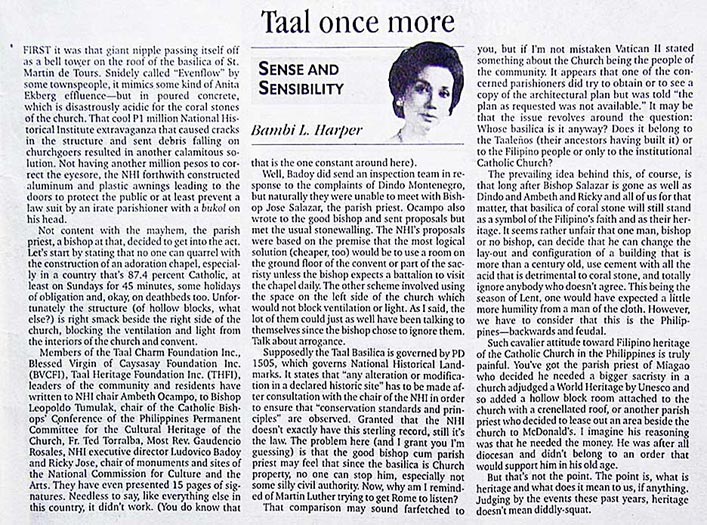
Taal once more
By Bambi L. Harper
Sense and Sensibility
Editor's Note: Published on March 6, 2004 issue of the Philippine Daily Inquirer.
FIRST it was that giant nipple passing itself off as a bell tower on the roof of the basilica of Saint Martin de Tours. Snidely called "Evenflow" by some townspeople, it mimics some kind of Anita Ekberg effluence -- but in poured concrete, which is disastrously acidic for the coral stones of the church. That cool one-million-peso extravaganza of the National Historical Institute (NHI) that caused cracks in the structure and sent debris falling on churchgoers resulted in another calamitous solution. Not having another million pesos to correct the eyesore, the NHI forthwith constructed aluminum and plastic awnings leading to the doors to protect the public or at least prevent a lawsuit by an irate parishioner with a "bukol" [swelling] on his head.
Not content with the mayhem, the parish priest, a bishop at that, decided to get into the act. Let's start by stating that no one can quarrel with the construction of an adoration chapel, especially in a country that's 87.4 percent Catholic, at least on Sundays for 45 minutes, some holidays of obligation and, okay, on deathbeds too. Unfortunately the structure (of hollow blocks, what else?) is right smack beside the right side of the church, blocking the ventilation and light from the interiors of the church and convent.
Members of the Taal Charm Foundation Inc., Blessed Virgin of Caysasay Foundation Inc. (BVCFI), Taal Heritage Foundation Inc. (THFI), leaders of the community and residents have written to NHI chairman Ambeth Ocampo, to Bishop Leopoldo Tumulak, chairman of the Catholic Bishops' Conference of the Philippines' Permanent Committee for the Cultural Heritage of the Church, Father Ted Torralba, Most Reverend Gaudencio Rosales, NHI executive director Ludovico Badoy, and Ricky Jose, chairman of monuments and sites of the National Commission for Culture and the Arts. They have even presented 15 pages of signatures. Needless to say, like everything else in this country, it didn't work. (You do know that that is the one constant around here).
Well, Badoy did send an inspection team in response to the complaints of Dindo Montenegro, but naturally they were unable to meet with Bishop Jose Salazar, the parish priest. Ocampo also wrote to the good bishop and sent proposals but met the usual stonewalling. The NHI's proposals were based on the premise that the most logical solution (cheaper, too) would be to use a room on the ground floor of the convent or part of the sacristy unless the bishop expects a battalion to visit the chapel daily. The other scheme involved using the space on the left side of the church in a way that would not block ventilation or light. As I said, the lot of them could just as well have been talking to themselves since the bishop chose to ignore them. Talk about arrogance.
Supposedly the Taal Basilica is governed by Presidential Decree 1505, which governs National Historical Landmarks. It states that "any alteration or modification in a declared historic site" has to be made after consultation with the chairman of the NHI in order to ensure that "conservation standards and principles" are observed. Granted that the NHI doesn't exactly have this sterling record, still it's the law. The problem here (and I grant you I'm guessing) is that the good bishop cum parish priest may feel that since the basilica is Catholic Church property, no one can stop him, especially not some silly civil authority. Now, why am I reminded of Martin Luther trying to get Rome to listen?
That comparison may sound farfetched to you, but if I'm not mistaken Vatican II stated something about the Catholic Church being the people of the community. It appears that one of the concerned parishioners did try to obtain or to see a copy of the architectural plan but was told "the plan as requested was not available." It may be that the issue revolves around the question: Whose basilica is it anyway? Does it belong to the people of Taal town (their ancestors had built it) or to the Filipino people or only to the institutional Catholic Church?
The prevailing idea behind this, of course, is that long after Bishop Salazar is gone as well as Dindo and Ambeth and Ricky and all of us for that matter, that basilica of coral stone will still stand as a symbol of the Filipino's faith and as their heritage. It seems rather unfair that one man, bishop or no bishop, can decide that he can change the lay-out and configuration of a building that is more than a century old, use cement with all the acid that is detrimental to coral stone, and totally ignore anybody who doesn't agree. This being the season of Lent, one would have expected a little more humility from a man of the cloth. However, we have to consider that this is the Philippines -- backwards and feudal.
Such cavalier attitude toward Filipino heritage of the Catholic Church in the Philippines is truly painful. You've got the parish priest of Miagao who decided he needed a bigger sacristy in a church adjudged a World Heritage by the UNESCO and so added a hollow block room attached to the church with a crenellated roof, or another parish priest who decided to lease out an area beside the church to McDonald's. I imagine his reasoning was that he needed the money. He was after all diocesan and didn't belong to an order that would support him in his old age.
But that's not the point. The point is, what is heritage and what does it mean to us, if anything. Judging by the events these past years, heritage doesn't mean diddly-squat.